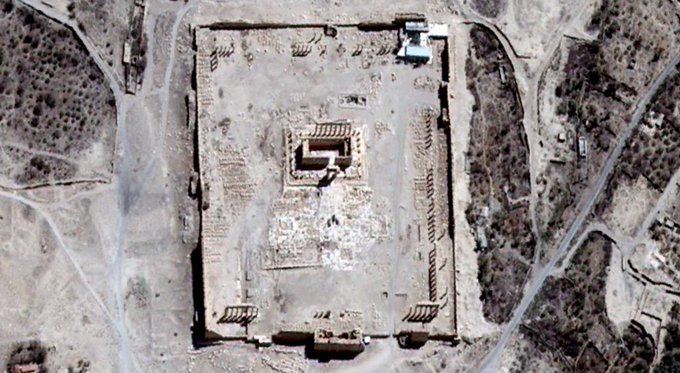Palmyra’s Temple of Bel withstood 2,000 years of war and invasions — until the Islamic State

A 19th century photo of the ruins at Palmyra. (Via the Freer Gallery of Art | Arthur M. Sackler Gallery Library, Smithsonian Institution Libraries)
It's unclear the extent to which the Islamic State has destroyed the ancient Temple of Bel, one of the most prominent sites in the archaeological complex at Palmyra, an ancient Syrian city currently in the grips of the jihadists.
The edifice of the temple, a 1st century structure that was one of the most important and iconic set of ruins in Palmyra, was supposedly damaged by explosives on Sunday afternoon. Subsequent reports claimed that the damage was only partial and that "the basic structure was still standing."
But a later set of U.N. satellite images, circulated on Monday, confirmed the worst:
Palmyra is being systematically destroyed by the Islamic State. Last week, it emerged that the extremist organization already blew up the Temple of Baal Shamin, another 2,000-year-old heritage site. Other structures and statues have also been vandalized or removed, in keeping with the jihadists ransacking of ancient Mesopotamian sites in Iraq.
It's a shocking state of affairs, especially when you consider Palmyra's antiquity. The city came to prominence in Roman times and withstood 20 centuries of war, shifting borders and conquering empires. Until the outbreak of Syria's ghastly civil war, it still drew in tens of thousands of tourists.
The Temple of Bel -- a Roman-era structure devoted to a Semitic deity -- was an embodiment of the city's eclectic, diverse cultural history. Here was a place where Greek, Latin, Aramaic and other tongues from lands to the east were all spoken.
As WorldViews discussed earlier, Palmyra emerged as a desert crossroads, an influential oasis linking the Roman and Persian worlds. It was for a time under the suzerainty of one of the Greek successor states that sprung up after the death of Alexander the Great, and later entered the orbit of Rome.
Its political peak was in the 3rd century A.D. The Roman Empire was in a period of relative crisis and instability, and saw some of its eastern domains overrun by the Persian Sassanian Empire. Odenathus, a Palmyran king, led the fight-back, eventually winning de facto command over much of Rome's territory in the East. But after he was assassinated by a rival in 268, his wife, the legendary ancient Queen Zenobia -- whose eyes, wrote the famed British historian Edward Gibbon, "sparkled with uncommon fire"-- ascended the throne as regent.
Zenobia set about actually building what was a new independent kingdom, with Palmyra at its center. Its authority extended north into Anatolia and south all the way into Egypt. But the Roman emperor Aurelian himself had enough and, through a combination of crafty diplomacy and brute force, isolated Zenobia and defeated her armies. In 273, after crushing a number of Palmyran revolts, Aurelian's armies sacked and razed Palmyra.
The city would never recover its political influence, but its great temples and colonnades remained. Aurelian ordered the Temple of Bel rebuilt. It became a Roman garrison town and later, under the Byzantines, a Christian village before the Arab Muslim invasions.
In the subsequent centuries, a host of empires and kingdoms would rise and fall around the ruins of Palmyra. The Umayyad dynasty, the first great Arab caliphate, built a fortress overlooking the ancient city; Byzantine and Persian architectural styles seen in Palmyra would be incorporated in subsequent Umayyad buildings elsewhere.
The Crusades raged not far from its gates; the soldiers of a succession of Arab, Kurdish, and Turkic dynasties likely marched through its arches. In 1400, a Mongol army swept through parts of Syria and and raided Palmyra, seizing some 200,000 sheep from its villagers. It went on to sack the great city of Aleppo, to Palmyra's north. A chronicler at the time described the raid "like a razor over hair" and "locusts over a green crop." A mountain of skulls was piled high outside Aleppo's city walls.
Palmyra survived, though, already a veteran of both natural and man-made disasters.
It fell into the hands of the Ottoman empire in the 16th century, and remained a dusty outpost (albeit, one with gorgeous ruins) until the 1900s. After World War I, Syria was seized by French mandate. Archaeological excavations in Palmyra began in earnest in the 1930s under French watch; villagers who had been living within the site's ruins, including inside the Temple of Bel, were relocated to new homes near the ancient city.
In 1941, as part of a wider incursion into Syria during World War II, an Allied mechanized division defeated a force loyal to Vichy France that was entrenched in Palmyra.
That would be the last major military engagement to take place by the ancient city for more than half a century. But the unraveling of the current Syrian regime has made Palmyra vulnerable to a new menace from which it may never recover.
Related on WorldViews




No comments:
Post a Comment